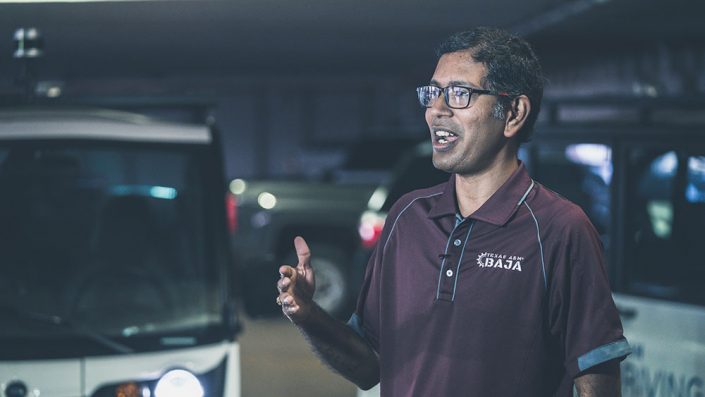A&M engineers launch autonomous shuttle project in Downtown Bryan

Image: College of Engineering
The self-driving shuttle system led by Texas A&M University researchers has officially launched in Downtown Bryan, giving the community an opportunity to experience the emerging technology in Aggieland.
Researchers said Downtown Bryan provides an ideal environment for the month-long test, which features two autonomous trolleys, thanks largely to its pedestrian-friendly layout in a relatively high-traffic area.
“The objective for these trolleys is to replace the need for some of the cars that clog up downtown,” Srikanth Saripalli, an associate professor in the J. Mike Walker ‘66 Department of Mechanical Engineering, said. “Downtown Bryan is perfect for this research because there are a lot of pedestrians and the city wants to make it a more walkable area. I think it’s a perfect environment for testing how these shuttles can actually work in the real world.”
Let by Saripalli, the project is a collaboration between the Texas A&M Engineering Experiment Station, the Texas A&M Transportation Institute, the College of Engineering and the City of Bryan.
The electric trolleys will initially run Monday through Friday in two-hour intervals between the hours of 10 a.m. and 4 p.m. on a fixed two-block route along Main Street and Regent Avenue between 26th Street and 29th Street, which is estimated to take roughly five minutes from start to finish. Designated stops will be marked by numbered A-frame signs.
Each of the autonomous vehicles will travel at a maximum of 7 to 10 mph and be monitored by two Texas A&M student workers who will act as the safety driver and the navigator, respectively. There will be space for four passengers on each of the two shuttles.
Saripalli and his team will be observing several technical and social factors as the trolleys are exposed to the public in Downtown Bryan’s vehicle and pedestrian-friendly space.
Among the most important metrics is how many times the vehicles experience “disengagement,” which is any time the human safety driver has to take control. Saripalli said examples range from having to manually slow the shuttle down or touching the steering wheel to disengaging for a break or the end of the run.
One measurement of success for the project, Saripalli said, will be determining if the team can reduce the number of disengagements for the trolleys over the test period.
All of the data collected from the test, including the number of and reasons for vehicle disengagements, will be posted online to allow for better transparency, increased awareness and acceptance of the shuttles.
“Currently there are a few tests being run by private companies, such as the Waymo and the GM Cruise, but the data is not public and is not available to the city planners and federal or state governments,” Saripalli said. “Our data will be open and will help city, state and federal officials determine the efficacy of such driverless vehicles both socially as well as technically.”

